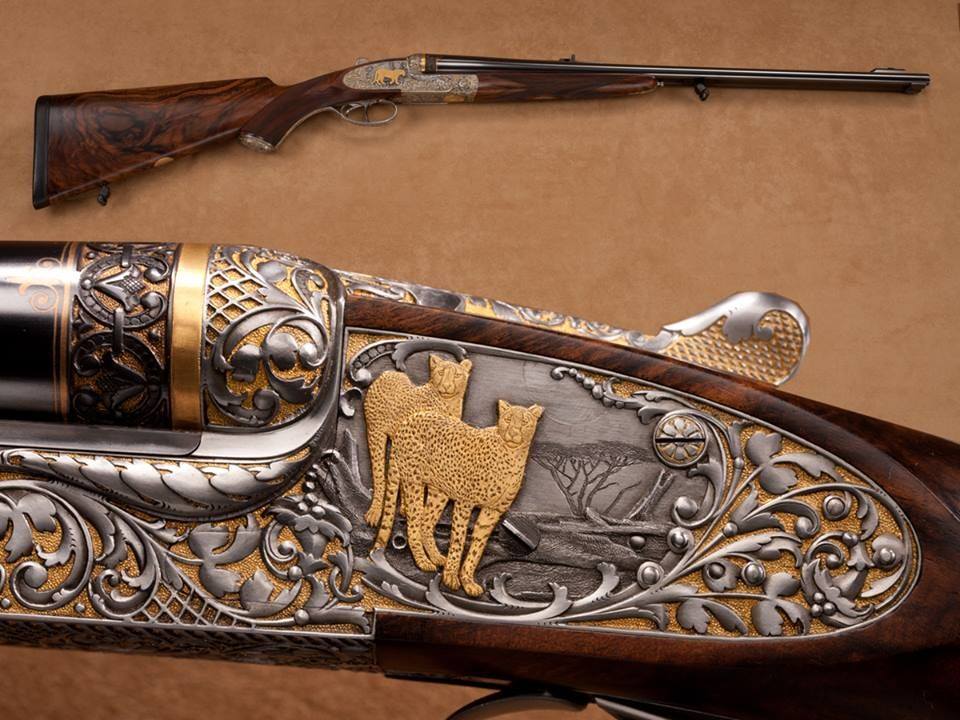Arguably the most versatile of all African cartridges, the .375 Holland & Holland Magnum is capable of taking the spectrum of Africa’s game – anything from duiker to elephant. It has more than a 100-year history – a highly successful and distinguished one at that – and is still today one of the most popular hunting calibres.
CALIBRE DESCRIPTION AND SPECIFICATIONS
The .375 H&H is a belted, rimless cartridge, with a maximum overall length of 3.6” (91.44mm).
The .375 H&H Magnum case design was conceived to use cordite – a stick type propellant used widely in the United Kingdom. The tapering cartridge body design and the small shallow shoulder are typical aspects of cartridges optimized for the use of this propellant. An advantage of such a case design is that it will feed and extract smoothly thus contributing to the cartridge’s reliability in the field.
Unlike previous cartridges, the .375 H&H operates at relatively higher pressures and was designed from the outset for use with smokeless powders that can generate higher pressures and thus higher velocities. However, when the cartridge was designed pressure levels were held to 47,000 psi (3,200 bar) as cordite was sensitive to temperature and could cause dangerously high pressures in the hot tropical climates of Africa and India. However, modern smokeless powders are not as sensitive to ambient temperatures as cordite and governing bodies nowadays allow for far higher allowable pressures (62 000 p.s.i) than the original loading of the cartridge (47 000 p.s.i).
The dimensions of this cartridge are shown in Figure 1.
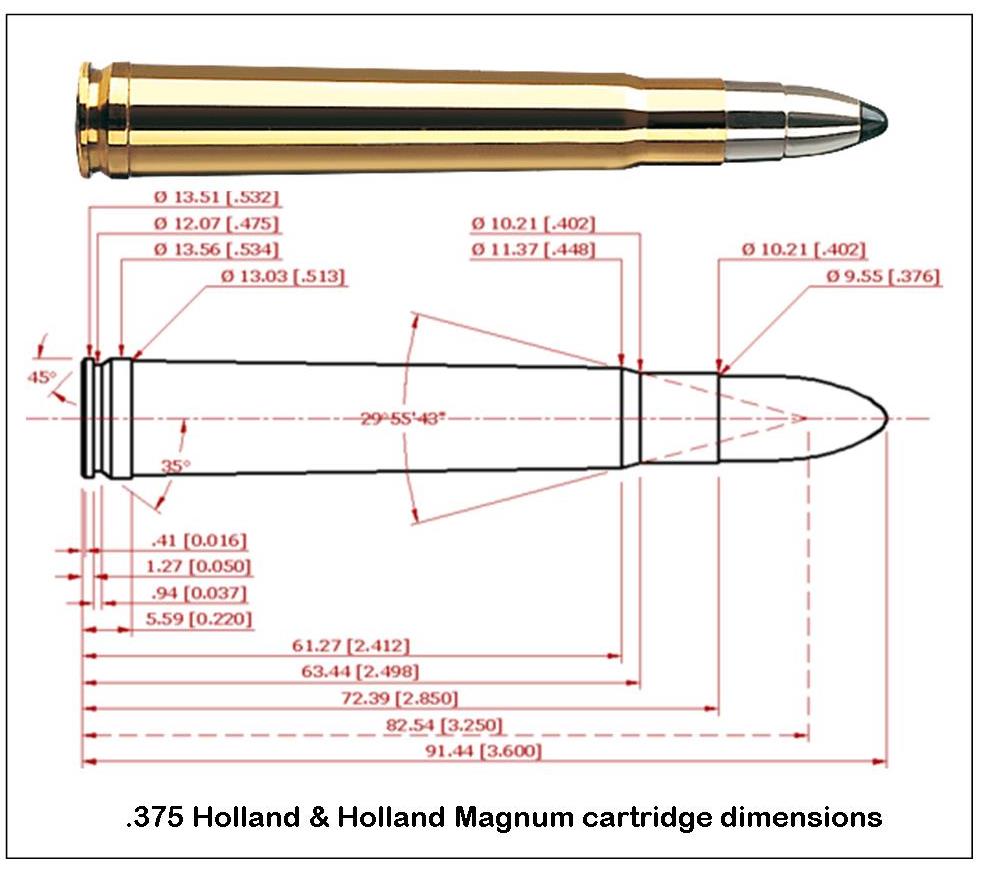
HISTORY
The cartridge was designed by the British firm Holland & Holland during 1909 – 1910 to improve on their .400/375 Nitro Express cartridge designed in 1905, which had shown poor performance. By 1912, Holland & Holland had completed tests on their new cartridge and, being satisfied with the results, launched the .375 H&H Magnum onto the market (Figure 2 and 3).

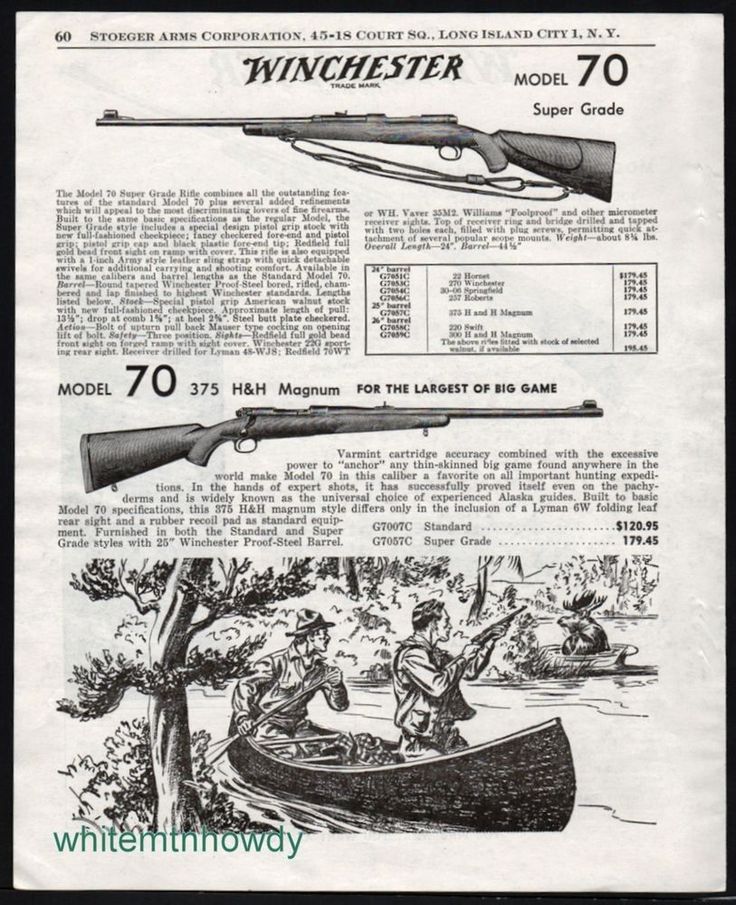
It was originally called the .375 Nitro Express Belted Rimless Magnum and was intended primarily for the big game animals of Africa but also became extensively used in India and on big North American species. Unfortunately the name of the specialist who actually conceived and designed the cartridge has been lost in the hallways of history but he was, without doubt, a visionary who created something totally different from that which was in vogue in those days and was dominated by the .400 and .500 calibres.
At birth the .375 H&H cartridge was a twin. The cartridge as we know it today is a rimless belted design intended for use in bolt-action repeating rifles. Its brother was a rimmed, beltless design intended for use in double rifles and loaded to lower average chamber pressures. Today the rimmed version has become an obscure, semi-obsolete novelty.
The bullet was designed with three bullet weights in mind:
A 235-grain bullet for small and plains game, a 270-grainer for heavy skinned non-dangerous game and lion, and a 300-grain bullet intended for the largest and toughest African game including hippo, buffalo, rhino and elephant. Solids were to be used for elephant, buffalo, hippo and rhino and expanding bullets for lion. The initial loadings used a 235-grain bullet at 2,800 fps, a 270-grain bullet at 2,650 fps and a 300-grain bullet at 2,500 fps.
There were a number of professional hunters in Africa who used this calibre. One of the most famous was Harry Manners – a quiet and gentle man who I had the honour to befriend in his latter days when he worked in the Kruger National Park. He hunted about 1000 elephant and other dangerous species in Mozambique using a Model 7o .375 Winchester. He shot 36 charging elephants with this calibre. However, it must be stated that he was a superb marksman and had an excellent knowledge of elephant anatomy, and knew exactly where to place a brain shot. He also shot some record “tuskers”, which he described in his book “Kambaku” using this calibre (Figure 4).
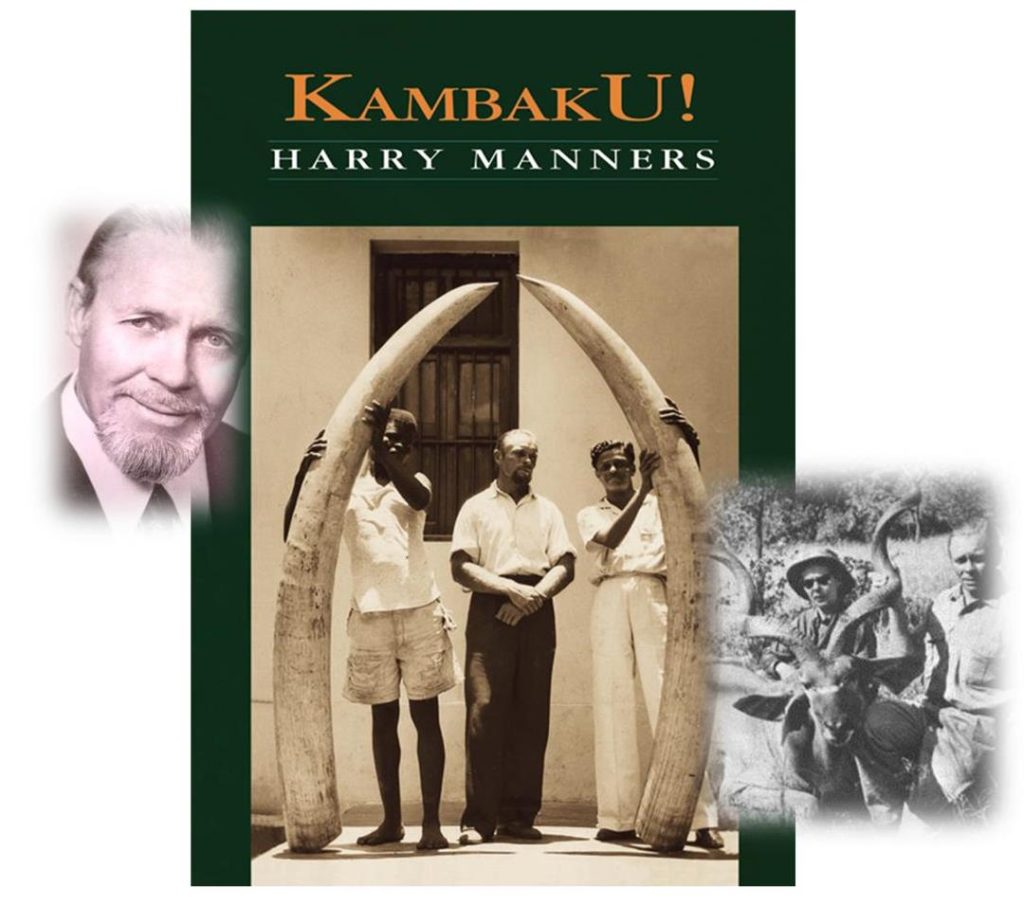
I was privileged to have him sign my copy of his book (Figure 5).
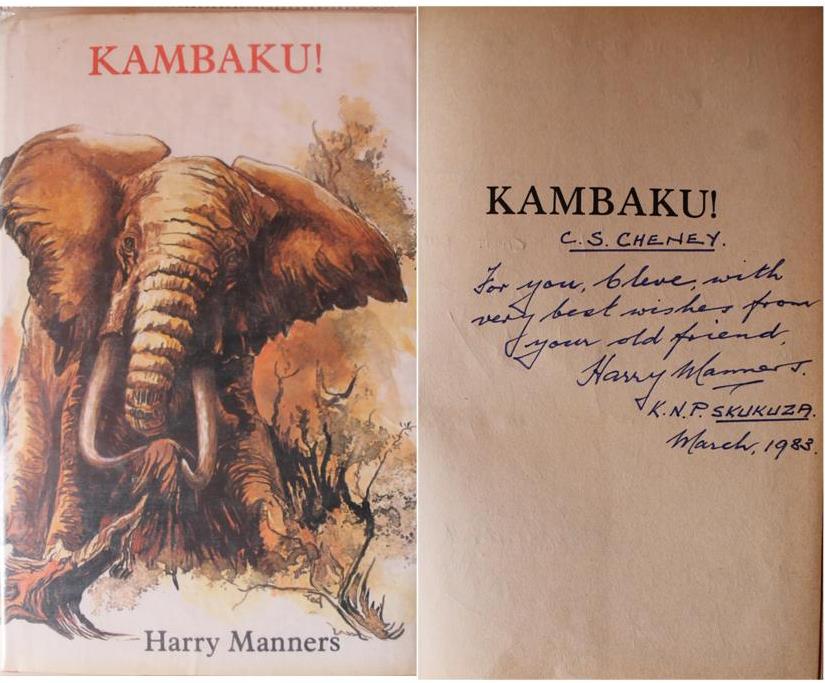
Many other professional hunters and game rangers also used the .375 H&H and were pleased with the results and had great confidence in this calibre. This included Peter Hankin in Zambia, Bruce Austen and John Osborne in Zimbabwe, and Wally Johnson in Mozambique. Syd Downey famed Kenyan hunter always recommended a .375 H&H to his clients. John “Pondoro” Taylor, Tony Sanchez-Arino, and George Rushby are also known to have been partial to this calibre (Figure 6).
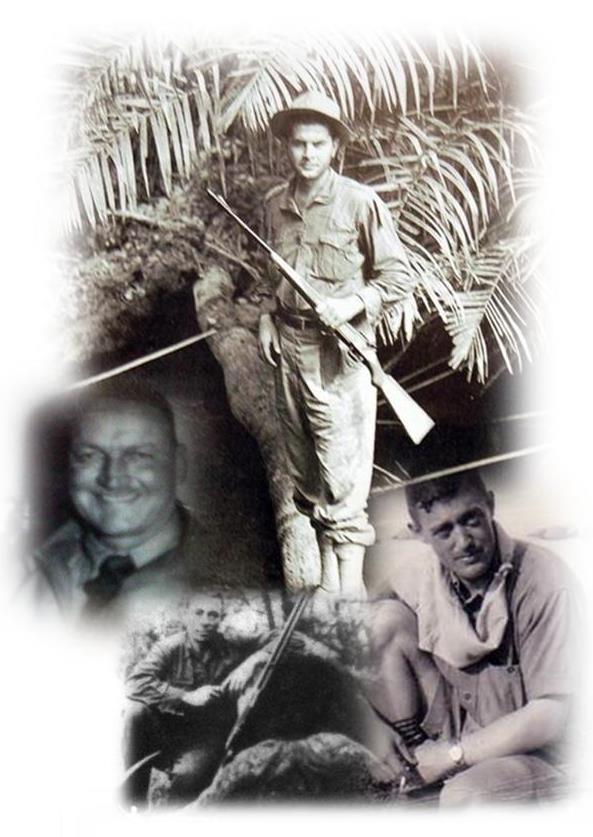
Two professional hunters – Francesco Salzone and a man known as “One Shot Araujo”- who were in charge of supplying buffalo meat to the Senna Sugar Company in Mozambique – shot over 4000 buffalo with the .375 H&H.
Many section rangers in the Kruger National Park had a preference for the .375. Two of them being my colleagues and friends Ted Whitfield and Johan van Graan. Ted was renowned for his marksmanship and proficiency with his .375. They accounted for many buffalo, elephant and hippo using this calibre and swore by it (Figure 7).
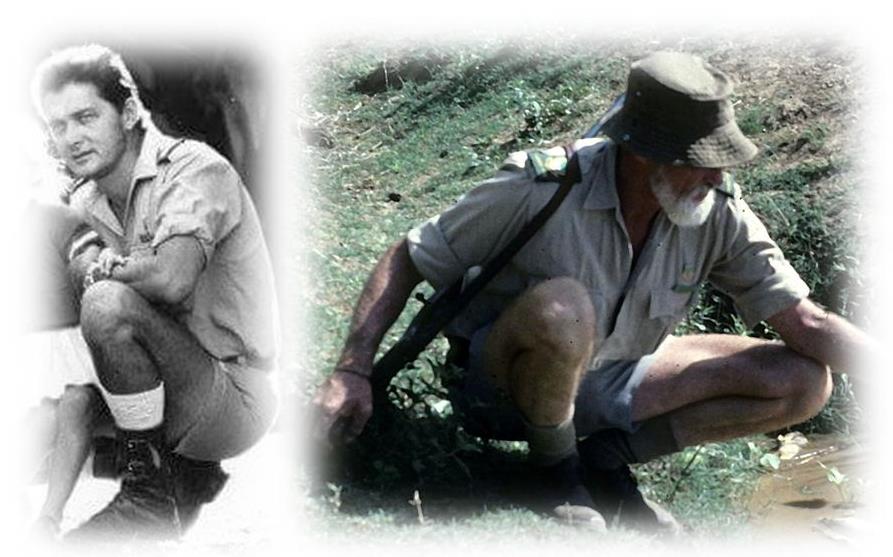
On the day when I shot my first three elephants, Johan van Graan being the “older” and more experienced ranger, was my backup. I was using a .458 Winchester Magnum and Johan his trusty .375. In these training sessions, elephants were induced to charge at us. The trainee was not allowed to shoot until the elephant was 20m away. The first elephant went well. One shot from my .458 at about 15m at the charging elephant dropped it in its tracks. The second elephant later on in the day did not go so well for me. Charging at full tilt my first shot had little effect, and neither did my second at about 12 meters.
That’s when Johan stepped in with his .375 and dropped the elephant at about 10 meters with a perfectly placed brainshot. My third elephant for the day ended up being two elephants charging at once. Calmly Johan told me to take the one on the right and he would take the one on the left. I was fortunate to drop my elephant with my first shot at about 18m. Johan had waited for me to shoot “my” elephant first and then again with a single shot dropped “his” elephant – again at about 10m with another excellent brain shot. I learned to have great respect for not only Johan van Graan and Ted Whitfield but also for their favourite calibre – the .375 Holland and Holland Magnum.
BALLISTICS
The .375 H&H Magnum cartridge has impressive credentials. It is known for its superior penetration – especially in thick-skinned and heavy-boned animals when solids of good construction are used. Typical ballistics for the .375 H&H Magnum are shown in Table 1 below.
One of the attractions of the .375 is that it has manageable and not unpleasant recoil. To get an idea of the recoil of the .375 H&H Magnum, the following table (Table 2) compares the Relative Recoil Factor (RRF) to other well-known calibres. The RRF is based on the muzzle momentum of the bullet and the expelled powder gas for a typical loading. In the family of big-game rifles, the .375 H&H has moderate recoil, making it a pleasure to shoot.
|
CALIBRE |
RELATIVE RECOIL FACTOR |
|
.270 Winchester |
1.82 |
|
.308 Winchester |
1.95 |
|
.375 H&H Magnum |
3.42 |
|
.416 Rigby |
4.27 |
|
.458 Winchester Magnum |
4.36 |
|
.500 Nitro Express 3-inch |
5.52 |
|
.700 Nitro Express |
9.00 |
Table 2: Relative Recoil Factors
RECOMMENDED FOR SPECIES
No one rifle, bullet, or calibre is suitable for all African game and hunting conditions but the .375 H&H Magnum, given its limitations, comes close (Table 3). Its limitations are that it is not intended for shots at plains game beyond 300 meters or for hunting dangerous, thick-skinned species in thick, dense bush or forest. The .375 H&H is, however, quite capable of taking all big dangerous game animals in open to medium-dense forest areas with good visibility.
|
SPECIES |
BULLET TYPE |
|
Plains game and small antelope |
235 – 300 grain soft points |
|
Leopard |
235-grain soft points |
|
Lion |
270 – 300 grain soft points |
|
Buffalo |
270 – 300 grain softs or expanding solids for heart shots 300-grain solids or expanding solids for brain shots |
|
Hippo |
270 – 300 grain softs for brain shots 300-grain solids for body or spinal shots |
|
Rhino |
300 grain solid |
|
Elephant |
|
Table 3: .375 Bullet type recommendations for a variety of species
Table 3: .375 Bullet-type recommendations for a variety of species
Whereas an elephant can be effectively killed with the .375 H&H, and thousands have been shot with this calibre it must be understood that there is a significant difference between calibres that can kill an elephant and those that can be relied upon to do so. Because of this, the .375 is regarded as a minimum, in terms of stopping power, for elephants. Accurate shot placement, especially in frontal brain shots, is critical with little room for error. Most African countries mandate the use of a .375 H&H as the minimum caliber for hunting dangerous game.
MANUFACTURERS of .375 H&H MAGNUM RIFLES
Most rifles in this calibre are built around Mauser actions. The cartridge is long and requires Magnum actions to be used. The CZ550 action is popular for custom building .375 H&H Magnum rifles (Figure 8).
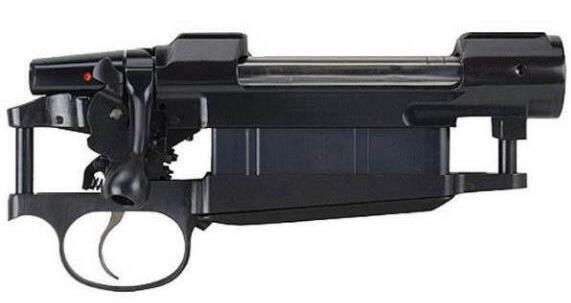
Because the .375 H&H Magnum is such a popular calibre rifles for it are made by most of the world’s firearm manufacturers including, Holland & Holland, Westley Richards, Purdey, Rigby, Jeffery, Remington, Sako, BRNO, Winchester, and Belgian gunmakers FN, Francotte and Dumoulin Figure 9. It is also available from some manufacturers as a double.
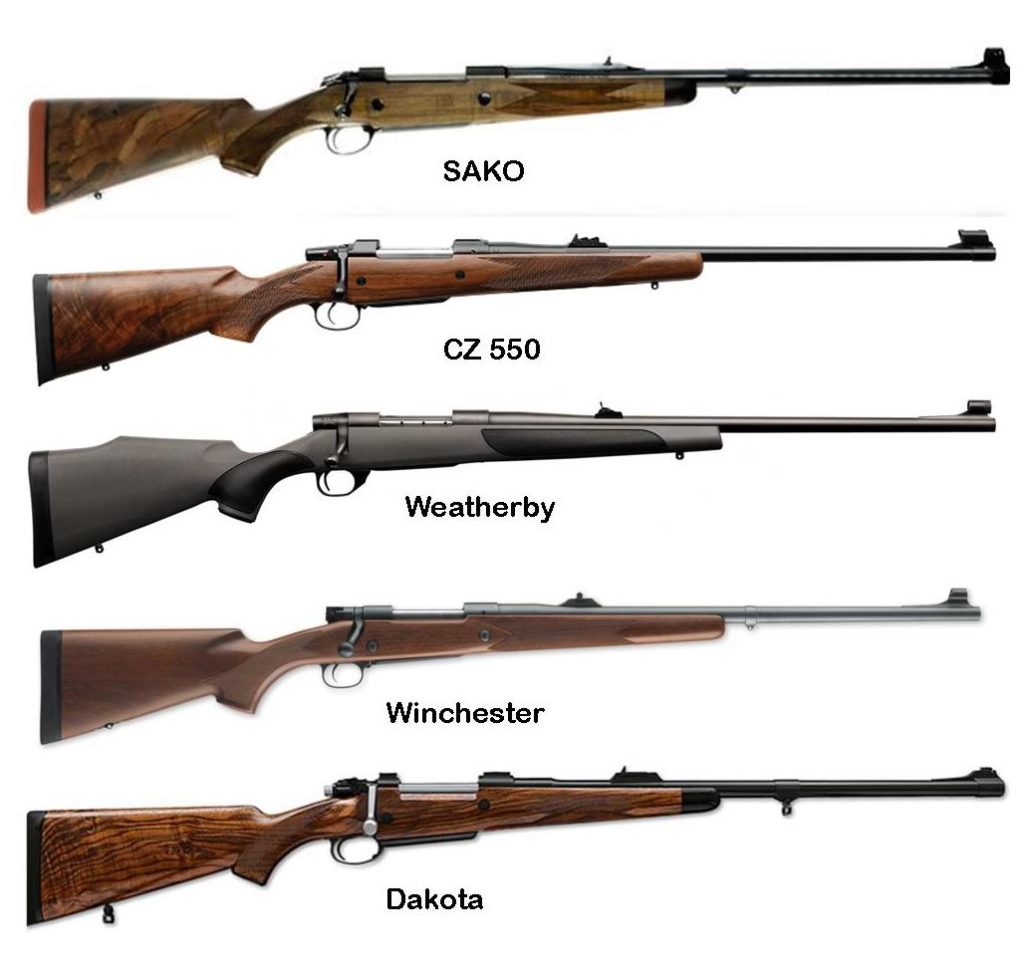
HANDLOADING THE .375 H&H MAGNUM
The .375 H&H may be a little problematic for reloaders in that it headspaces on the belt rather than the shoulder, and case stretch will limit reloads to three or four cycles before incipient head separation occurs if one is full-length case resizing. By using slightly milder loads or using a neck-sizing die, case life will be dramatically prolonged. Local Somchem S335 and S355 powders can be used to load the .375 H&H Magnum (Table 4). What makes the .375 H&H a delight to reload / handload is that, because it is such a popular calibre, one has a big variety of components to choose from.
|
POWDER |
CASE |
PRIMER |
BULLET grains |
*LOAD grains |
VELOCITY fps |
MUZZLE ENERGY Ft. lbs |
|
S335 |
PMP |
PMP |
210gr Barnes”X” |
64.1 |
2772 |
3584 |
|
270gr Barnes”X” |
59.1 |
2402 |
3460 |
|||
|
300gr Barnes”X” |
57.0 |
2273 |
3442 |
|||
|
S355 |
PMP |
PMP |
210gr Barnes”X” |
68.4 |
2710 |
3425 |
|
270gr Barnes”X” |
63.9 |
2408 |
3477 |
|||
|
300gr Barnes”X” |
59.4 |
2194 |
3207 |
BULLETS & FACTORY AMMO FOR THE .375 H&H MAGNUM
There are a number of excellent cartridges available for the .375 H&H, usually in the 270 – 300 grain range in both soft point, expanding solid and solid bullet options from Norma, Federal, Hornady, Remington, Barnes, Swift, A-Square, and the local PMP brands. Table 5 gives a sampling of some factory ammunition available for the .375 H&H. Figure 10 shows Norma factory cartridges available for the .375 H&H Magnum.
|
BULLET |
MUZZLE ENERGY Ft-lbs |
MUZZLE VELOCITY fps |
|
Federal 250 grain Trophy Bonded Bear Claw |
3957 |
2670 |
|
Federal 270 grain Jacketed Soft Point |
4338 |
2690 |
|
Federal 300 grain Woodleigh Hydro Solid |
4163 |
2500 |
|
Federal 300 grain Trophy Bonded Sledgehammer Solid |
3966 |
2440 |
|
PMP 286 grain solid |
3947 |
2493 |
|
PMP 300 grain SP |
3926 |
2428 |
|
PMP 300 grain A-Frame bonded |
3807 |
2391 |
|
Norma Barnes TSX 270 grain |
4132 |
2625 |
|
Norma Swift A-Frame 300 grain |
4363 |
2559 |
|
Norma Woodleigh SN 350 grain |
4112 |
2300 |
|
Norma VOR-TX FMJ 350 grain |
4112 |
2300 |
|
Norma 300 grain solids |
4333 |
2250 |
|
Barnes 300 grain TSX Flat Base |
4299 |
2540 |
|
Swift 350 grain SP |
4112 |
2300 |
|
Swift 350 grain FMJ |
4112 |
2300 |
|
Swift 300 grain A-frame |
4363 |
2559 |
There is a wide range of bullets available for the .375 H&H for handloaders Figure 11 shows some examples of what is available.
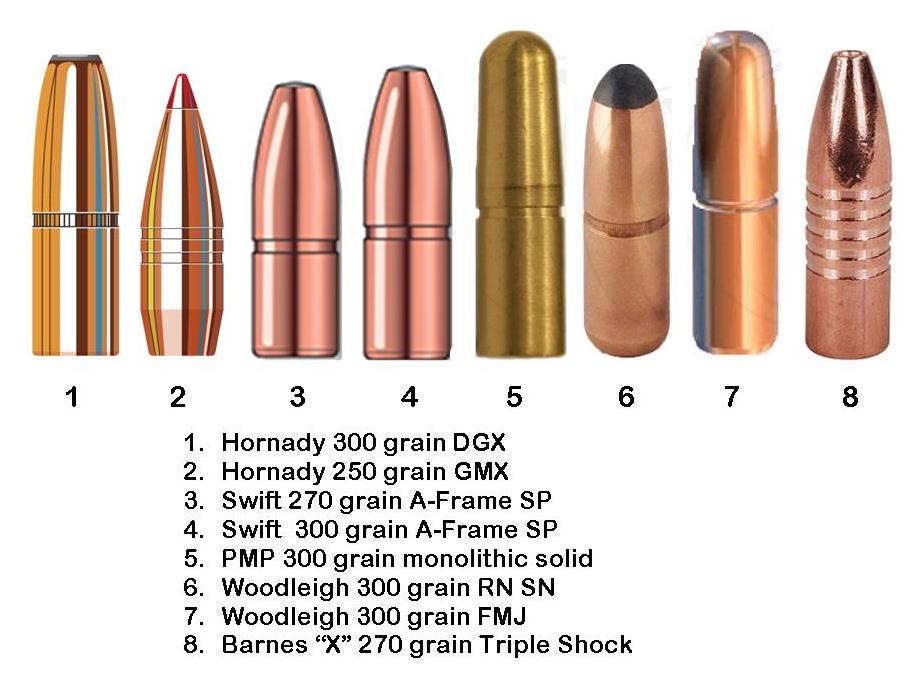
THE FUTURE
With a more than a 100 years of an enviable reputation behind it and so sign of its popularity waning, the amazing .375 H&H Magnum cartridge can, in all likelihood, look forward to another century. If I had to choose a calibre for a “one gun battery,” I know what it would be.

